#WE SHOULD BE LOOKING FORWARD FOR USING AND TRANSITIONING TO RENEWABLE ENERGY SOURCES
Text
Don't forget the reason the U.S. is supporting Israel's genocide of Palestine - hell, 90% of the reason they ever get involved into something in the Middle East is for ulterior purposes regarding oil.
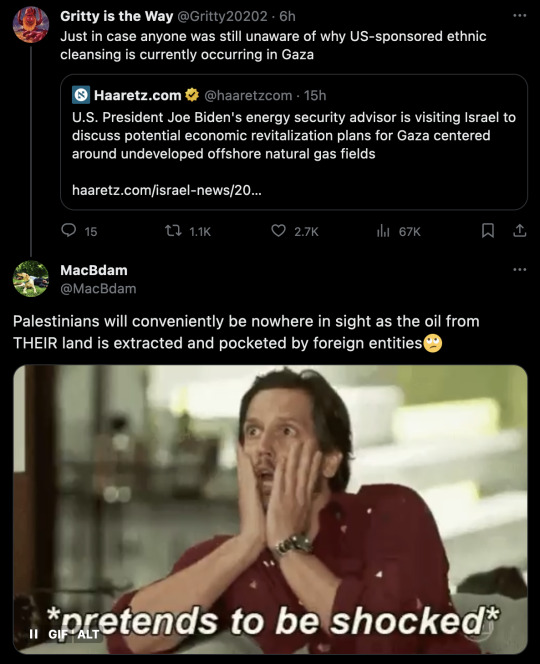

That and the Ben Gurion Canal project, which you can learn more about:
Also this short video explaining the canal's significance and full history in summary:
Simply put,
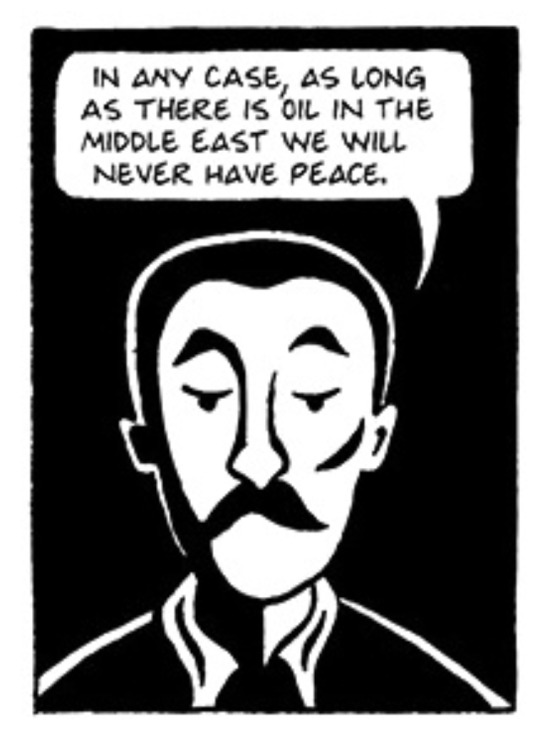
#free palestine#israel is a genocidal state#israel is a terrorist state#fuck america#fuck israel#comic pic is from persepolis btw#which is an autobiography of the author growing up in iran during the iranian revolution#not to mention how the US destabilized iran bc their democratically elected leader was gonna nationalize its oil for iran#and they put someone who would play ball for them in charge#its always about the oil#EVEN IN THE MIDST OF EVERYONE GOING “THE FUTURE ISNT VIABLE W FOSSIL FUELS”#WE SHOULD BE LOOKING FORWARD FOR USING AND TRANSITIONING TO RENEWABLE ENERGY SOURCES#BUT THE CAPITALISTIC FUCKS WANT MONEY NOW#AT THE EXPENSE OF HUMAN LIVES#THE LIVES OF ARABS AND BROWN PPL INDIGENOUS TO PALESTINE NOTE THAT#aaaaaaand of course the canal#much easier than dealing w egypt#for both israel and america#israel will be onboard w them and they'll have a way of strengthening their grip on the middle east and world economy#this is honestly disgusting and terrifying#egypt#suez canal
62 notes
·
View notes
Text
Amazon Bestselling Author NJ Ayuk Outlines an Energy Plan for Africa
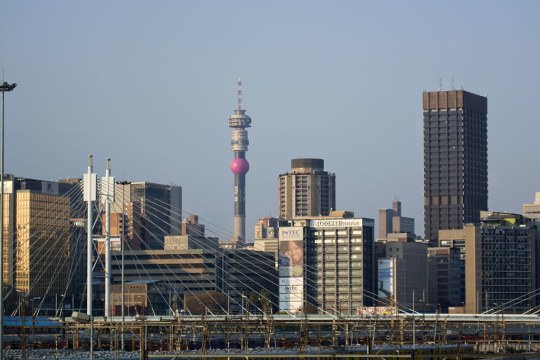
As the world attempts to respond to the recent energy shakeup in a way that accounts for the Russia-Ukraine war, post-pandemic supply chain issues, and the near-emergence of sustainable solutions, fossil fuels in Africa have become a hot topic of debate. Author NJ Ayuk, executive chairman of the African Energy Chamber, believes there’s a way forward that will not only help the world meet its current energy needs, but can also benefit the millions of Africans currently living without electricity.
Ayuk’s book, A Just Transition: Making Energy Poverty History With an Energy Mix, is a finely tuned argument for helping the African people by leveraging the continent’s vast reserves of oil and natural gas.
Author NJ Ayuk lays an argument that favors the 600 million Africans who currently live without access to electricity and the 900 million people on the continent who lack access to clean cooking technologies. Central to his argument is the fact that Africa produces less than 3% of the world’s carbon emissions yet is home to about 17% of the global population.
“We need an energy transition, but it has to be a just energy transition,” he stated. “I think our challenge right now is to figure out a way to be fighting climate change and energy poverty at the same time. I think there is a very Western misconception about the needs of everyday people in Africa, where the dialogue is just based on a desire to save the planet. Yes, we want to save the planet. We all should want that. But climate change and energy poverty are two sides of the same coin.
“We have to do both. We have to make energy poverty history. You can’t talk about denying Africa a way to help 900 million people, most of them women, who are living their lives without having their very basic needs met, because of the emissions that have benefited other countries.”
In addition to writing books and heading the AEC, NJ Ayuk is the founder of the international firm Centurion Law Group, which does much of its legal work in and around the energy sector in Africa.
His experience in the industry has led NJ Ayuk to some policy prescriptions that can help Africa — and the world — fare better in the next century. He believes that by creating an energy mix that allows some countries to continue using fossil fuels while others transition to more sustainable offerings is the right way to move everyone forward.
“When you really look at where we are right now and you look at where we are going, people are saying, ‘Let’s abandon natural gas and just concentrate on a transition to renewables.’ But what does that look like for people in Africa? What are you going to transition from — from the dark to the dark?” he asked. “You need to have something to start with, then you can transition. Africa’s energy emissions are not even up to 3% of the world’s carbon. So [places] like Europe or the United States that are somewhere in the 20s or the 30s, they need to decarbonize and they need to decarbonize fast. Africa needs to be given a chance to industrialize.”
The book comes at a crucial moment in international relations. As Europe continues to seek new sources of energy to replace the fossil fuels that many countries were purchasing from Russia, African reserves have become a key area of interest. This represents a chance to right some of the former wrongs that have been visited on Africa by Western countries while also correcting social injustices that continue to exist.
Many of the social injustices revolved around a community that has long been overlooked, both on a global stage and specifically in Africa.
“We can’t talk about a just energy transition without seeing African women being a big part of that,” NJ Ayuk said. “Let’s be honest: The energy industry has done a horrible job when it comes to anything to do with women. It’s not even something we need to be proud of — we need to be ashamed. Women are still the last hired and the first fired in our industry. Women's issues have just been very overlooked, and we really hope that when we are talking about a transition, this does not repeat itself.
“Whether it’s with the grain economy or whatever you see, if it's a replacement of what you’ve seen in the fossil fuel industry with the grain industry, then it’s going to be really despicable. It even happens in the clean energy sector. Women today are still receiving less than 2% of the investments in that sector. We have to change that.”
0 notes
Text
New Moon in Aries: Powerful Beginnings
The New Moon will be on April 11th, 2021. This is the Moon of renewal or starting fresh and making major plans. Aries Season is still here which is going to make us move if we have been slacking off and make us more productive. It can feel like a rough time with the aspect to Pluto, but we can still feel the positive energy thanks to Jupiter. Appreciate and enjoy the stellium in Aries because it can make us all reach for the stars.
Aries – The New Moon in your sign is going to present a positive moment during your birthday season. You are going to explore relationship dynamics, self-expression and will feel more prepared to tackle and complete tasks or challenges that you might have been avoiding. A period of renewal awaits you.
Taurus – With the energy this New Moon brings it is a build up a week before your season enters. Soon you will have the anchor of Venus pushing you up to new heights as your ruler gives you a new direction. You are closing the nebulous Aries Season with more insight and confidence as you prepare for the new changes ahead.
Gemini – During this transit, you are going to feel your creativity reach new heights as you experience unexpected sources of inspirations from friends and romantic partners. The New Moon puts things in perspectives for you as you see the results from your hard work and efforts.
Cancer – These transits are going to make you reach new heights as the New Moon in Aries has you shining at the top of the mountain. Here you will continue to plan your next course of action as you make moves to solidify your future.
Leo – Aries Season gives you the spark and inspiration to move ahead with what you have been dreaming of. There will be lessons learned now that will motivate you to explore your dreams for the future. Set your sights on greater things and manifest them.
Virgo – Reflection is the main theme for you during this transit. It could bring you back to a time where you had a romance, and the moments of nostalgia might creep back in. The New Moon will prompt you to face the past and look forward to the future.
Libra – Another powerful transit you will be experiencing. As the sister sign, you are feeling the reflective energy from the Sun, Venus, and Mercury. Now the New Moon is going to make you look deep within and exercise your independence. Expect to feel braver during this transit.
Scorpio – There have been things you might have been putting off and this New Moon is a friendly reminder to get back to focusing on yourself. This can be the treat yourself Moon as you find new ways to enliven your daily routines, your workout methods or just find more time to meditate.
Sagittarius – As a fire sign, the energy this New Moon will bring is going to leave a dose of excitement and hope. Exercise your creative power because it might surprise you just how much you can do during this period. Aries Season is yours for the taking. Keep pushing to get to new heights.
Capricorn – As Pluto squares this New Moon, it could make you feel the intense energy the most since Pluto is still in your sign. Nevertheless, you are going to enjoy what this transit has to offer as you feel yourself evolving and transforming. This can show you just how to balance power at work or in school. Times of stress mean you should focus on self-care breaks.
Aquarius – Lucky for you, this New Moon makes positive aspects to your sign, especially Jupiter. You feel the optimistic energy brewing as you feel more enlightened and emboldened to pursue new intellectual activities. This is an energy for learning and expanding which only makes things more fruitful for you in the long run.
Pisces – You are prepared for what the New Moon has to offer. With Venus already in this sign, you are learning to love and appreciate yourself. This is your time to be more demanding with the types of people you welcome in your life. Expect to feel bolder and wiser after this transit.
#New Moon in Aries#Astrology#Horoscopes#Aries#Taurus#Gemini#Cancer#Leo#Virgo#Libra#Scorpio#Sagittarius#Capricorn#Aquarius#Pisces
276 notes
·
View notes
Text
World After Capital: Plan for Part Four
NOTE: I have been posting excerpts from World After Capital on Mondays. But because I am doing a more substantial rewrite of Part Four, today’s post describes what I am planning to cover.
I want Part Four to be more practical by pointing out ways we can take responsibility today for making the transition to the Knowledge Age. Here are areas I am planning to cover. I am curious if anyone has additional suggestions. First there are direct contributions to the three freedoms.
1. Mindfulness research and applications (Psychological Freedom)
There have been recent breakthroughs in understanding the physiological and neurological underpinnings of mindfulness practices. More work here is needed including ranging from foundational (such as mathematical models of the neural networks) to practical (such as treatment with Psilocybin and other psychedelic drugs). There are also great opportunities to contribute to mindfulness through computer applications, from practice apps such as Simple Habit to more elaborate ones based on reading brainwave activity. Finally, there is a ton of work to be done around embedding mindfulness in to our every day applications such as email, social media, etc.
2. UBI advocacy and politics (Economic Freedom)
For the first time with Andrew Yang there is a candidate running on a UBI platform for 2020 presidential elections. People can volunteer for his campaign. Even if that comes to an end there are other ways to engage in moving the idea of UBI forward. There are several ongoing research projects, such as the one in Kenya run by Give Directly. There is work on policies that can provide an onramp to UBI, such as the Economic Security Projects evaluation of an expanded Earned Income Tax Credit.
3. Creating open source and Creative Commons content, advancing protocols (Informational Freedom)
While reforming is copyright is hard (still someone should work on that) it is much easier to create reduce the restrictions of copyright for content by making it available as Creative Commons. Same goes for software that is made available under an open source license. Finally there is a lot of work these days on open protocols, particularly in the blockchain area. All of these can help advance informational freedom now. Of course it would also be great to have more people advocate for better policies.
Above and beyond working on these three freedoms, there are other foundational areas that require work if we are to transition successfully into the Knowledge Age. These include
1. Fighting Climate Change
Climate change is a clear and present danger. Much of the current way of living including where on the world people are, how they are fed, where water comes from are on the brink of changing dramatically. We are not prepared for the degree of change that’s ahead and if we don’t intervene now there is a high likelihood of cataclysmic change with massive loss of human lives ahead. There is a multi prong approach that’s required. We need to aggressively work on non carbon based energy sources (not just solar and renewables but also nuclear, including further work on fusion), we must have some kind of carbon tax style regulation and because we are late we need to research ways of delaying the big change such as solar radiation management. If you are looking for a model of what to do,
2. Defending Democracy
It is sometimes argued that democracy cannot successfully make big transitions and that we should look to different models for the change we need. People point to China as an example of a technocratic government that they claim is doing a better job coping with change. And it is entirely true that many democracies are struggling today. Nonetheless I believe it is essential that we redouble our efforts to defend democracy. This is a rich field of engagement including working on the campaigns of new candidates, fighting gerrymandering at the state level, innovating on voting methods with rank choice voting and experimental techniques such as quadratic voting.
3. Advancing Humanism
This may strike some as the least important of the areas I have mentioned for engagement so far. And while it may have the least short term impact it strikes me as the most important in the long run. What does it even mean to engage here? For starters I think it is about advancing the thinking around what a revived modern humanism needs to look like. I have taken a stab at that but much remains to be done, such as a deeper exploration of the moral consequences. Then there is the need to package humanism as memes that can spread online. Of starting a movement that can grow.
There are of course many other important ways people can contribute to the Knowledge Loop today and in the future that will also help move us forward towards the Knowledge Age.
As I am reworking this, I would love to hear whether people think of these suggestions and what other areas of engagement I absolutely should cover.
1 note
·
View note
Text
April 4, 2021
My weekly roundup of things I am up to. Topics include ammonia in shipping, industrial collapse, and an angiogram.
Ammonia for Shipping
This week I continued a more detailed exploration of the prospect of alternative fuels for vehicles.
About 2% of world energy consumption goes to international shipping, with another ~0.5% for domestic shipping. By ton-miles, most freight is transported by ship. Aside from associated greenhouse gases, shipping fuel tends to be heavy fuel oil, which is particularly bad with regard to air pollution when burned. Seaports, which are typically located around prime real estate in major cities, take a brunt of this pollution. For these reasons, there is great interest in developing low-pollution, low-emission fuels for shipping. The International Maritime Organization, the international agency that regulates shipping, has set a goal of a 70% reduction of greenhouse gas emissions by 2050, relative to 2008 levels.
A 2019 report from Maersk analyzed several shipping fuel options and concluded that three of them are the most viable low-carbon candidates: ammonia, alcohol (e.g. methanol and ethanol), and synthetic methane. Liquified natural gas ships are starting to become common thanks to low natural gas prices, though this isn’t synthetic or a low-carbon fuel. I plan to look in more detail at LNG and methanol for shipping later on.
Among other options, hydrogen for shipping is plausible, but the technology is farther from being ready for prime time. Sails (wind power) has been used for shipping; it is a fine idea and brings romantic memories of the Age of Sail, but nowadays sailing can only augment and not replace other fuels. Battery electric ships are starting to come into use for short distance vessels such as ferries, but the energy density is insufficient for transoceanic voyages. Nuclear-powered shipping is well established in military applications and can be done for container ships, but for now it looks like it is too expensive, and there would be a hornet’s nest of safety and regulatory issues. It is a bit worrisome that, while nuclear shipping is a priority for nuclear advocates, particularly of small modular reactors, it doesn’t seem to be even on the radar of most shippers and shipping advocates, who don’t have much of a stake in debates about energy sources.
Anyway, DNV thinks that ammonia is the most promising long term option. By the analysis I’ve done, ammonia shipping will be more expensive, but the use of ammonia produced from steam methane reforming without carbon capture and sequestration (the most common method now) would have a carbon abatement cost of a rather affordable $24/ton. With CCS, the abatement cost rises to $95/ton, and it is $258/ton when hydrogen is produced by electrolysis from low-carbon sources. That’s based on prevailing worldwide renewable energy prices, and the figure is no doubt less in areas such as Australia, which has cheap and abundant solar power.
There are still quite a few issues to work out. For one thing, there are no container ships that use ammonia today, though a model is expected to be ready in 2024. Although ammonia pipelines are widespread, as ammonia has been commonly used for fertilizer and other chemicals for a long time, there are logistical issues with expending pipelines or other ammonia transportation to seaports. Because ammonia is a lower energy density than diesel, more space on the ship would have to be dedicated to fuel, which cuts into cargo space.
On the plus side, ammonia is already a cost-effective solution under a reasonable valuation of carbon emissions and even ignoring other air pollutants, and the economics should only get better. There are several ammonia production methods under development which could lower costs; most exciting is the prospect of bypassing hydrogen production in a process that mimics what plants do with photosynthesis. Low carbon energy should continue to get cheaper in the coming years.
Industrial Collapse
Samo Burja had another well-written but downbeat article on Palladium a couple weeks ago entitled “The End of Industrial Society”. It’s a good read, though I would take the scenario outlined here as a possibility rather than a prediction.
Samo argues, correctly in my view, that the transition to “post-industrial” societies represents a step backwards, rather than forwards, and he notes that some commentators try to spin this transition as success rather than failure. Dietrich Vollrath, in Fully Grown, stands out as a particular offender here. Vollrath channels an argument that seems to be accepted wisdom among wide swathes of the social elite, that low productivity growth (or stagnation) and low fertility are rational decisions to pursue leisure over socially productive ventures. The argument is not too dissimilar to what Tyler Cowen has been saying, except Cowen writes about these trends in a disapproving way.
Samo also notes that industrialization is a society-wide phenomenon, encompassing the full range of values and institutions of a society or even a civilization. An industrial mindset is embedded in the population, which takes the form of “tricks of the trade” knowledge that we chalk up to experience. I don’t think this phenomenon is well-studied, but hints of it do appear in topics such as Wright’s Law. Many of the proposed responses then, such as tariffs, public R&D programs, or other polices under the header of “industrial policy” are likely to turn out to be cargo cult solutions, in that they fail for a lack of understanding of what industrialization is really about and what drives it.
Deindustrialization, or post-industrialization, are trends that are at risk of exaggeration. Data from the Fed shows that manufacturing in the US, for instance, has been relatively flat since around 2005, with some fluctuations associated with recessions. This is probably a more pessimistic trend than would have been expected at the time, but it hardly indicates that industry has disappeared. More noticeable has been the decline in workers in manufacturing, all the more stark when you consider that this chart does not account for growth in the overall workforce size. A few years ago, these trends led to a panic about “robots taking our jobs”, a panic that has largely subsided now in the face of observations of low productivity growth and a pre-pandemic labor market that was one of the strongest in American history. Still, the hope of transitioning to a successful post-industrial society, in the sense that industrial society was post-agrarian, does not seem to be entirely in vain.
Angiogram
On April 1, I was in the hospital for an angiogram, the purpose of which was to check on the surgery I had last summer to make sure that the cerebral hemorrhage and other observable problems were resolved. It was supposed to happen in January, but Kaiser closed to elective procedures as a result of the third COVID wave.
Everything went well. Most importantly, no neurological problems were detected. The worst part about the operation was the anxiety I had beforehand. The surgeons had to put a catheter into my wrist to make the observations. But it wasn’t so bad. I would consider the whole thing to be uncomfortable but not painful. I’m due for an MRI next year, but there should be no more angiograms.
I chose the date of April 1 because it was the earliest date available when I scheduled it. But yes, I know that isn’t the most auspicious of days to go into the hospital. Actually, though, I’m a little disappointed that there weren’t any (harmless) practical jokes. But joking aside, modern medicine is nothing short of miraculous.
0 notes
Text
D&D Dungeon Design: Flow, Rhythm, and Pacing
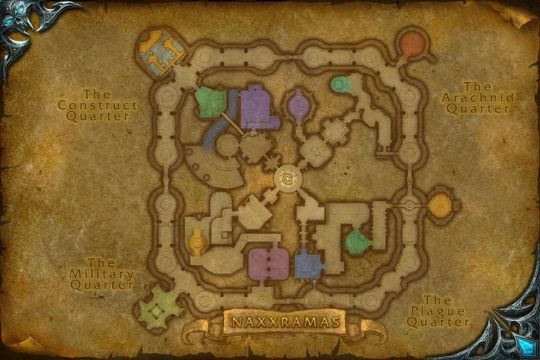
image source: World of Warcraft instance map of the Naxxramas dungeon
My last post talked about the concepts of contrast relating to dungeon design. Here I want to explore how sequencing of contrast builds anticipation and then later resolves that anticipation. It’s basically a study in how to create drama in your dungeon. Let’s define a few things first:
Flow: The emotional movement of dungeon encounters/spaces in sequence.
Rhythm: Variation or lack thereof in the sequencing of dungeon encounters/spaces.
Pacing: The changes in tempo/emotion of the rhythm and flow of a dungeon.
When I say dungeon encounters/spaces, I mean that these can refer to encounter difficulty, encounter type, room design, monster types, or anything else in your dungeon that can be put into sequence. Use rhythm, flow, and pacing as abstract concepts when planning out all parts of your dungeon. Now let’s see how these can be used:
Flow
Flows, in general, are how balanced your dungeon design is. Think of flow like a line graph, moving up and down as emotional response increases. It can change slowly or quickly, increasing or decreasing, depending on your design. If story is important to you, this is what you want to hone in your dungeon.
Think how you want players to feel at the beginning of a dungeon and at the end and the journey to get there. For instance, you might want players entering a dungeon with a sense of anticipation and a desire to explore the unknown, then slowly uncover the mysteries of the dungeon until they discover a big reveal at the end. That would be a flow. Another flow might be wanting the players to be at a high sense of energy entering a dungeon, maybe chasing someone into it, then have short repeated bursts of encounters, until there is a calming when they discover the person they were chasing has died. There is a calm ending to the dungeon once they discover there is different kind of threat lurking in another dungeon somewhere.
These are two very different flows, but it offers enough information to help you plan encounters around them. Of course players are radical variables and you can never plan for everything, but having a strong skeleton to fall back on only makes your dungeon and the story stronger.
Rhythm
Rhythm is the parts of a dungeon that create or compose its flow. Low contrast between encounters or rooms will create anticipation. Moments of high contrast resolve the anticipation with drama, leaving players satisfied. The transitions between them compose the rhythm. Depending on what you planned for your dungeon’s flow, you can craft a rhythm that supports it.
Variety
Strong rhythms show variety. Variety keeps players invested with small bursts of the anticipation-drama reaction; sometimes imperceptible compared to payoff moments like boss battles or NPC deaths or ambushes. However noticeable, they are still necessary. Without this variety in energy, players either get bored from a lack of drama or get tired from too much drama. You don’t want that.
Think of rhythm like a good song (rhythm and music together, who knew?) It has high points AND low points. It either surprises you or eases you in. It keeps you interested, keeps you invested, and keeps you moving forward using moments of anticipation and resolving it. That is the goal of rhythm: to propel you through the dungeon’s flow.
Repetition
Repeating or echoing aspects of your dungeon can be powerful and increases anticipation as players wait for a break in the repetition. This isn’t to say that all your dungeon rooms/encounters should look identical, but a little bit of repetition goes a long way in the rhythm of your dungeon.
Imagine some powerful songs that use repetition. My favorite (and my current ringtone) is Hans Zimmer’s Wonder Woman theme. There’s a certain lick that is repeated, like two or three notes in sequence, that builds up anticipation until the phrase resolves (you can tell because there’s like a foghorn noise immediately after it resolves and it’s epic and heck).
For a dungeon example, I ran a dungeon that was an ancient dwarven treasure vault/prison. I had eyes occasionally appear on the walls about three times. Only one person kept seeing it. Everyone else assumed they were mad. The dungeon map was a bit labyrinthine but very structured and symmetrical, up until the final boss area where the built anticipation paid off: A disordered and asymmetrical cave structure beneath the vault where a once-imprisoned Beholder had escaped and built its home. The repeated eye sightings resolved in the Beholder, and the dramatic change in scenery was the resolution of the rest of the dungeon.
Pacing
Rhythm and flow help the players get an idea in their head of the dungeon in your head. Together rhythm and flow create the pacing of the dungeon and its story. I’m going to take you through a simple and abstract dungeon layout to see pacing in action.

Imagine the above image is a layout of your next big dungeon. It’s a straight line, evenly spaced out, and every room is a near-identical box to put encounters in. It works, but it’s hardly innovative and will easily bore your players especially in their mind’s eye. Let’s add some rhythm to it:
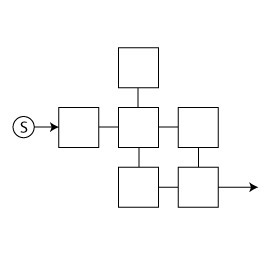
This version is more interesting. There are more paths to choose from, despite them all leading to the same place. This gives players more of a sense of agency as they proceed to explore the space rather than follow it. Moreover, as players backtrack and explore the variations between predictability (“We’ve already been in this room”) and discovery (“Oh hey, a new room!”) creates some rhythm. Let’s keep going:

Now we have varied the size of the rooms and length of the connectors/hallways. Room size creates a noticeable variety by contrasting large and small rooms. Entering a large room from a small one is a breath of fresh air and a renewed sense of discovery as players wonder what the room holds. Entering a small room from a large one makes players more anxious and ready for an ambush or trap. This push-and-pull is a rhythm that results in an overall flow.
Hallway length here is just as important. A short hallway is like walking through a door. Sure, there’s a bit of distinction between the rooms but the tension is immediately broken as soon as it began. It literally and emotionally quickens the pacing. A longer hallway increases tension as players start to wonder why the hallway is so long, possibly anticipating something bigger on the other end of it. “Length” of a hallway doesn’t have to be physical, it can be made through difficulty. A sheer rock face to climb is a “long” hallway as it takes a long time to get from one room to the next. It’s nothing but a skill check meant to increase anticipation. Let’s try something else.

Adding variety through shapes, as mentioned in my post on contrast, brings new meaning to the dungeon layout as a whole. The northern/top wing of this dungeon is more likely to be traversed first because of it’s more amicable shapes and shorter initial hallway length. These are, of course, abstracted concepts but you get the idea. The flow has changed to start with a sense of curiosity in the diamond-shaped hub room where they are offered a choice, then a sense of security in the northern wing (with its rounded rooms and comfortable sizes), and then a sense of unease in the south-western room (being cramped, angular, and asymmetrical), and finally a resolution of that tension in the final room (which is bigger, slightly more round, and easier to navigate).
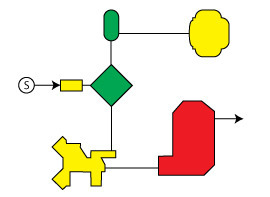
If we add some indication of difficulty, the dungeon has become a full-fledged Piet Mondrian piece. Green is an easy encounter, yellow is hard, and red is deadly. There is a new sense of rhythm and flow that offers almost full insight into the pacing of this dungeon. The final room’s meaning has also changed; while it resolves the visual anticipation, it has a deadly encounter placed within it. The room’s visual amicability balances the encounter’s technical threat. This means that while the rhythm and flow of different aspects have changed, the pacing remains the same. The end of the dungeon is a high-energy boss battle and a chance for players to stretch their legs and use their biggest and baddest abilities without inhibitions.

Here’s a graph of the pacing of our dungeon in terms of emotional energy(assuming the northern wing is explored first). It’s got variety with the ups and downs. The low points have easy encounters or simple rooms. The backtracking part is a break after the northeastern room’s medium difficulty as they walk back to the hub room (the diamond shape), then explore the southern wing. During this backtracking anticipation builds, which is amplified by the southwestern room, culminating in the climax of the final, most difficult room. The transition is still smooth because of the aforementioned balancing of the room. Finally the tension breaks down after the final encounter. This simple line tells a story using flow and rhythm. Pacing also includes speed and time, which is a lot more difficult to gauge. We can safely assume that the more difficult the encounter or more complex the room, the longer it will take for players. Thus the graph is still fairly useful for measuring pacing.
I feel like I was all over the place with this article and speaking in sweeping generalizations and abstract terms, but I hope that the ideas of flow, rhythm, and pacing have come across as a tool for you to help build a memorable and exciting adventure for your players!
#level design#d&d#dungeons and dragons#dungeon master#dm#gm#dungeon#dungeon design#storytelling#flow#rhythm#pacing#tempo#dnd#dungeons & dragons#dmg#roleplaying#design#writing#plot
866 notes
·
View notes